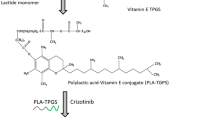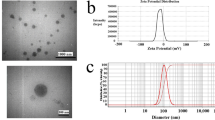Abstract
A doxorubicin-loaded mannitol-functionalized poly(lactide-co-glycolide)-b-d-α-tocopheryl polyethylene glycol 1000 succinate nanoparticles (DOX-loaded M-PLGA-b-TPGS NPs) were prepared by a modified nanoprecipitation method. The NPs were characterized by the particle size, surface morphology, particle stability, in vitro drug release and cellular uptake efficiency. The NPs were near-spherical with narrow size distribution. The size of M-PLGA-b-TPGS NPs was ~110.9 nm (much smaller than ~143.7 nm of PLGA NPs) and the zeta potential was −35.8 mV (higher than −42.6 mV of PLGA NPs). The NPs exhibited a good redispersion since the particle size and surface charge hardly changed during 3-month storage period. In the release medium (phosphate buffer solution vs. fetal bovine serum), the cumulative drug release of DOX-loaded M-PLGA-b-TPGS, PLGA-b-TPGS, and PLGA NPs were 76.41 versus 83.11 %, 58.94 versus 73.44 % and 45.14 versus 53.12 %, respectively. Compared with PLGA-b-TPGS NPs and PLGA NPs, the M-PLGA-b-TPGS NPs possessed the highest cellular uptake efficiency in A549 and H1975 cells (lung cancer cells). Ultimately, both in vitro and in vivo antitumor activities were evaluated. The results showed that M-PLGA-b-TPGS NPs could achieve a significantly higher level of cytotoxicity in cancer cells and a better antitumor efficiency on xenograft BALB/c nude mice tumor model than free DOX. In conclusion, the DOX-loaded M-PLGA-b-TPGS could be used as a potential DOX-loaded nanoformulation in lung cancer chemotherapy.






Similar content being viewed by others
References
Ferlay J, Shin HR, Bray F, Forman D, Mathers C, Parkin DM. Estimates of worldwide burden of cancer in 2008: GLOBOCAN 2008. Int J Cancer. 2010;127:2893–917.
Bunn PA Jr. Worldwide overview of the current status of lung cancer diagnosis and treatment. Arch Pathol Lab Med. 2012;136:1478–81.
Mei L, Zhang Z, Zhao L, Huang L, Yang XL, Tang J, et al. Pharmaceutical nanotechnology for oral delivery of anticancer drugs. Adv Drug Deliv Rev. 2013;65:880–90.
Zhang C, Wang W, Liu T, Wu Y, Guo H, Wang P, et al. Doxorubicin-loaded glycyrrhetinic acid-modified alginate nanoparticles for liver tumor chemotherapy. Biomaterials. 2012;33:2187–96.
Zeng X, Tao W, Wang Z, Zhang X, Zhu H, Wu Y, et al. Docetaxel-loaded nanoparticles of dendritic amphiphilic block copolymer H40-PLA-b-TPGS for cancer treatment. Part Part Syst Charact. 2015;32:112–22.
Chauhan VP, Jain RK. Strategies for advancing cancer nanomedicine. Nat Mater. 2013;12:958–62.
Juliano R. Nanomedicine: is the wave cresting? Nat Rev Drug Discov. 2013;12:171–2.
Liang R, Wang J, Wu X, Dong L, Deng R, Wang K, et al. Multifunctional biodegradable polymer nanoparticles with uniform sizes: generation and in vitro anti-melanoma activity. Nanotechnology. 2013;24:455302.
Zhang X, Dong Y, Zeng X, Liang X, Li X, Tao W, et al. The effect of autophagy inhibitors on drug delivery using biodegradable polymer nanoparticles in cancer treatment. Biomaterials. 2014;35:1932–43.
Han S, Liu Y, Nie X, Xu Q, Jiao F, Li W, et al. Efficient delivery of antitumor drug to the nuclei of tumor cells by amphiphilic biodegradable poly(l-aspartic acid-co-lactic acid)/DPPE co-polymer nanoparticles. Small. 2012;8:1596–606.
Meng J, Liang X, Chen X, Zhao Y. Biological characterizations of [Gd@C82(OH)22]n nanoparticles as fullerene derivatives for cancer therapy. Integr Biol. 2013;5:43–7.
Zeng X, Tao W, Mei L, Huang L, Tan C, Feng SS. Cholic acid-functionalized nanoparticles of star-shaped PLGA-vitamin E TPGS copolymer for docetaxel delivery to cervical cancer. Biomaterials. 2013;34:6058–67.
Huang L, Chen H, Zheng Y, Song X, Liu R, Liu K, et al. Nanoformulation of d-alpha-tocopheryl polyethylene glycol 1000 succinate-b-poly(epsilon-caprolactone-ran-glycolide) diblock copolymer for breast cancer therapy. Integr Biol. 2011;3:993–1002.
Hussein-Al-Ali SH, Arulselvan P, Fakurazi S, Hussein MZ, Dorniani D. Arginine–chitosan-and arginine–polyethylene glycol-conjugated superparamagnetic nanoparticles: preparation, cytotoxicity and controlled-release. J Biomater Appl. 2014;29:186–98.
Zhu H, Chen H, Zeng X, Wang Z, Zhang X, Wu Y, et al. Co-delivery of chemotherapeutic drugs with vitamin E TPGS by porous PLGA nanoparticles for enhanced chemotherapy against multi-drug resistance. Biomaterials. 2014;35:2391–400.
Jiang T, Singh B, Li HS, Kim YK, Kang SK, Nah JW, et al. Targeted oral delivery of BmpB vaccine using porous PLGA microparticles coated with M cell homing peptide-coupled chitosan. Biomaterials. 2014;35:2365–73.
Tao W, Zeng X, Zhang J, Zhu H, Chang D, Zhang X, et al. Synthesis of cholic acid-core poly([varepsilon]-caprolactone-ran-lactide)-b-poly(ethylene glycol) 1000 random copolymer as a chemotherapeutic nanocarrier for liver cancer treatment. Biomater Sci. 2014;2:1262–74.
Segat D, Tavano R, Donini M, Selvestrel F, Rio-Echevarria I, Rojnik M, et al. Proinflammatory effects of bare and PEGylated ORMOSIL-, PLGA- and SUV-NPs on monocytes and PMNs and their modulation by f-MLP. Nanomedicine (Lond). 2011;6:1027–46.
Toraya-Brown S, Sheen MR, Baird JR, Barry S, Demidenko E, Turk MJ, et al. Phagocytes mediate targeting of iron oxide nanoparticles to tumors for cancer therapy. Integr Biol. 2013;5:159–71.
Tao W, Zeng X, Liu T, Wang Z, Xiong Q, Ouyang C, et al. Docetaxel-loaded nanoparticles based on star-shaped mannitol-core PLGA-TPGS diblock copolymer for breast cancer therapy. Acta Biomater. 2013;9:8910–20.
Luderer F, Löbler M, Rohm HW, Gocke C, Kunna K, Köck K, et al. Biodegradable sirolimus-loaded poly(lactide) nanoparticles as drug delivery system for the prevention of in-stent restenosis in coronary stent application. J Biomater Appl. 2011;25:851–75.
Zhang Z, Tan S, Feng SS. Vitamin E TPGS as a molecular biomaterial for drug delivery. Biomaterials. 2012;33:4889–906.
Muthu MS, Kulkarni SA, Xiong J, Feng SS. Vitamin E TPGS coated liposomes enhanced cellular uptake and cytotoxicity of docetaxel in brain cancer cells. Int J Pharm. 2011;421:332–40.
Mi Y, Liu Y, Feng SS. Formulation of Docetaxel by folic acid-conjugated d-alpha-tocopheryl polyethylene glycol succinate 2000 (Vitamin E TPGS(2 k)) micelles for targeted and synergistic chemotherapy. Biomaterials. 2011;32:4058–66.
Li PY, Lai PS, Hung WC, Syu WJ. Poly(l-lactide)-vitamin E TPGS nanoparticles enhanced the cytotoxicity of doxorubicin in drug-resistant MCF-7 breast cancer cells. Biomacromolecules. 2010;11:2576–82.
Mi Y, Zhao J, Feng SS. Vitamin E TPGS prodrug micelles for hydrophilic drug delivery with neuroprotective effects. Int J Pharm. 2012;438:98–106.
Tan GR, Feng SS, Leong DT. The reduction of anti-cancer drug antagonism by the spatial protection of drugs with PLA-TPGS nanoparticles. Biomaterials. 2014;35:3044–51.
Zhao J, Mi Y, Feng SS. Targeted co-delivery of docetaxel and siPlk1 by herceptin-conjugated vitamin E TPGS based immunomicelles. Biomaterials. 2013;34:3411–21.
Pridgen EM, Alexis F, Kuo TT, Levy-Nissenbaum E, Karnik R, Blumberg RS, et al. Transepithelial transport of Fc-targeted nanoparticles by the neonatal fc receptor for oral delivery. Sci Transl Med. 2013;5:213ra167.
Feng SS, Mei L, Anitha P, Gan CW, Zhou W. Poly(lactide)-vitamin E derivative/montmorillonite nanoparticle formulations for the oral delivery of Docetaxel. Biomaterials. 2009;30:3297–306.
Li D, Ping Y, Xu F, Yu H, Pan H, Huang H, et al. Construction of a star-shaped copolymer as a vector for FGF receptor-mediated gene delivery in vitro and in vivo. Biomacromolecules. 2010;11:2221–9.
Ma D, Lin QM, Zhang LM, Liang YY, Xue W. A star-shaped porphyrin-arginine functionalized poly(l-lysine) copolymer for photo-enhanced drug and gene co-delivery. Biomaterials. 2014;35:4357–67.
Kozak D, Anderson W, Vogel R, Chen S, Antaw F, Trau M. Simultaneous size and zeta-potential measurements of individual nanoparticles in dispersion using size-tunable pore sensors. ACS Nano. 2012;6:6990–7.
Shi J, Xiao Z, Kamaly N, Farokhzad OC. Self-assembled targeted nanoparticles: evolution of technologies and bench to bedside translation. Acc Chem Res. 2011;44:1123–34.
Shi J, Votruba AR, Farokhzad OC, Langer R. Nanotechnology in drug delivery and tissue engineering: from discovery to applications. Nano Lett. 2010;10:3223–30.
Prabaharan M, Grailer JJ, Pilla S, Steeber DA, Gong S. Folate-conjugated amphiphilic hyperbranched block copolymers based on Boltorn H40, poly(l-lactide) and poly(ethylene glycol) for tumor-targeted drug delivery. Biomaterials. 2009;30:3009–19.
Zhao J, Feng SS. Effects of PEG tethering chain length of vitamin E TPGS with a Herceptin-functionalized nanoparticle formulation for targeted delivery of anticancer drugs. Biomaterials. 2014;35:3340–7.
Liu Y, Feng SS. The synergistic effect of herceptin and docetaxel in polylactide-d-alpha-tocopheryl polyethylene glycol succinate (PLA-TPGS) nanoparticles. J Control Release. 2011;152(Suppl 1):e64–5.
Rothenfluh DA, Hubbell JA. Integration column: biofunctional polymeric nanoparticles for spatio-temporal control of drug delivery and biomedical applications. Integr Biol. 2009;1:446–51.
Kamaly N, Xiao Z, Valencia PM, Radovic-Moreno AF, Farokhzad OC. Targeted polymeric therapeutic nanoparticles: design, development and clinical translation. Chem Soc Rev. 2012;41:2971–3010.
Schutz CA, Juillerat-Jeanneret L, Mueller H, Lynch I, Riediker M. Therapeutic nanoparticles in clinics and under clinical evaluation. Nanomedicine (Lond). 2013;8:449–67.
Ungaro F, d’Angelo I, Coletta C, di Villa d’Emmanuele, Bianca R, Sorrentino R, Perfetto B, et al. Dry powders based on PLGA nanoparticles for pulmonary delivery of antibiotics: modulation of encapsulation efficiency, release rate and lung deposition pattern by hydrophilic polymers. J Control Release. 2012;157:149–59.
Bin Y, Sheng-Yong G, Jin-Ye W. Physical stability of cholesterol derivatives combined with liposomes and their in vitro behavior. Eng Med Biol Soc (EMBC), 2013 35th Annual International Conference of the IEEE 2013. pp. 4114–4117.
Peng Z, Wang CX, Fang EH, Lu XM, Wang GB, Tong Q. Co-delivery of doxorubicin and SATB1 shRNA by thermosensitive magnetic cationic liposomes for gastric cancer therapy. PloS One. 2014;9:e92924.
Shin SJ, Beech JR, Kelly KA. Targeted nanoparticles in imaging: paving the way for personalized medicine in the battle against cancer. Integr Biol. 2013;5:29–42.
Parchur AK, Ansari AA, Singh BP, Hasan TN, Syed NA, Rai SB, et al. Enhanced luminescence of CaMoO4: Eu by core@shell formation and its hyperthermia study after hybrid formation with Fe3O4: cytotoxicity assessment on human liver cancer cells and mesenchymal stem cells. Integr Biol. 2014;6:53–64.
Costa RR, Girotti A, Santos M, Arias FJ, Mano JF, Rodriguez-Cabello JC. Cellular uptake of multilayered capsules produced with natural and genetically engineered biomimetic macromolecules. Acta Biomater. 2014;10:2653–62.
Shima F, Uto T, Akagi T, Baba M, Akashi M. Size effect of amphiphilic poly(gamma-glutamic acid) nanoparticles on cellular uptake and maturation of dendritic cells in vivo. Acta Biomater. 2013;9:8894–901.
Collnot EM, Baldes C, Wempe MF, Kappl R, Huttermann J, Hyatt JA, et al. Mechanism of inhibition of P-glycoprotein mediated efflux by vitamin E TPGS: influence on ATPase activity and membrane fluidity. Mol Pharm. 2007;4:465–74.
Acknowledgments
The authors are grateful for financial support from the National Natural Science Foundation of China (No. 31270019, 51203085), Science, Technology & Innovation Commission of Shenzhen Municipality (No. JCYJ20140718171607436), and Program for New Century Excellent Talents in University (NCET-11-0275).
Disclosure
The authors report no conflicts of interest in this work.
Author information
Authors and Affiliations
Corresponding authors
Additional information
Jinxie Zhang, Wei Tao, Yuhan Chen have contributed equally to this work.
Rights and permissions
About this article
Cite this article
Zhang, J., Tao, W., Chen, Y. et al. Doxorubicin-loaded star-shaped copolymer PLGA-vitamin E TPGS nanoparticles for lung cancer therapy. J Mater Sci: Mater Med 26, 165 (2015). https://doi.org/10.1007/s10856-015-5498-z
Received:
Accepted:
Published:
DOI: https://doi.org/10.1007/s10856-015-5498-z




